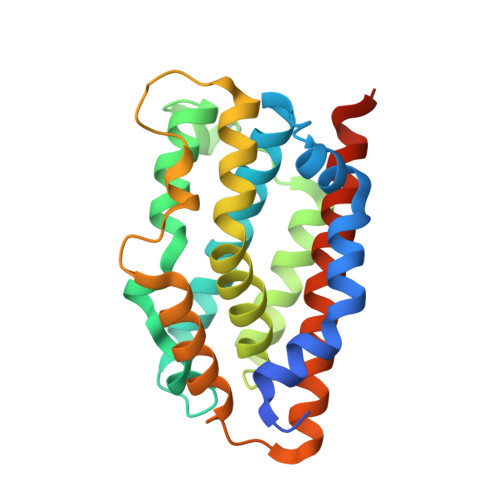Regiospecificity determinants of human heme oxygenase: differential NADPH- and ascorbate-dependent heme cleavage by the R183E mutant.
Wang, J., Lad, L., Poulos, T.L., Ortiz de montellano, P.R.(2005) J Biological Chem 280: 2797-2806
- PubMed: 15525643
- DOI: https://doi.org/10.1074/jbc.M411229200
- Primary Citation of Related Structures:
1XK2, 1XK3 - PubMed Abstract:
The ability of the human heme oxygenase-1 (hHO-1) R183E mutant to oxidize heme in reactions supported by either NADPH-cytochrome P450 reductase or ascorbic acid has been compared. The NADPH-dependent reaction, like that of wild-type hHO-1, yields exclusively biliverdin IXalpha. In contrast, the R183E mutant with ascorbic acid as the reductant produces biliverdin IXalpha (79 +/- 4%), IXdelta (19 +/- 3%), and a trace of IXbeta. In the presence of superoxide dismutase and catalase, the yield of biliverdin IXdelta is decreased to 8 +/- 1% with a corresponding increase in biliverdin IXalpha. Spectroscopic analysis of the NADPH-dependent reaction shows that the R183E ferric biliverdin complex accumulates, because reduction of the iron, which is required for sequential iron and biliverdin release, is impaired. Reversal of the charge at position 183 makes reduction of the iron more difficult. The crystal structure of the R183E mutant, determined in the ferric and ferrous-NO bound forms, shows that the heme primarily adopts the same orientation as in wild-type hHO-1. The structure of the Fe(II).NO complex suggests that an altered active site hydrogen bonding network supports catalysis in the R183E mutant. Furthermore, Arg-183 contributes to the regiospecificity of the wild-type enzyme, but its contribution is not critical. The results indicate that the ascorbate-dependent reaction is subject to a lower degree of regiochemical control than the NADPH-dependent reaction. Ascorbate may be able to reduce the R183E ferric and ferrous dioxygen complexes in active site conformations that cannot be reduced by NADPH-cytochrome P450 reductase.
- Department of Pharmaceutical Chemistry, University of California, San Francisco, California 94143-2280, USA.
Organizational Affiliation:


















